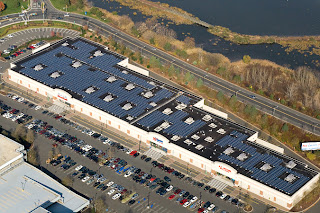Rooftops may not be the final frontier, but they do provide ample fields for cultivating solar panels.
So says Al Weinrub, who has penned "Community Power: Decentralized Renewable Energy in California." Weinrub is a member of the Sierra Club California Energy-Climate Committee and serves on the Steering Committee of the Bay Area’s Local Clean Energy Alliance. He said he relied extensively on work from both.
"Decentralized generation means that local residences, businesses, and communities become electric power producers," he writes. "Businesses with large rooftops or parking lots can become small power companies that feed electricity into the grid."
The beauty is that these buildings are already connected to the electrical grid and have an existing footprint, benefits that a remote solar installation doesn't always have. Industrial solar on empty land requires extensive permitting, studies and review of environmental impact, especially if its federal. Those panels definitely can change a picturesque landscape.
Buildings offer many acres of alternative energy opportunity. Just check out John Majoris' work at solaraerials.com for a King Kong view of some pretty amazing projects.
Rooftop power
Sandy Nax and I came to a similar conclusion over the the past year or so. Actually our former governor said the same thing and we agreed: The otherwise unused rooftops of the acres of warehouses in Fresno/San Joaquin Valley provide a great place for easy-to-permit solar and a cheap additional crop to be farmed on those rather ugly asphalt-topped fields.
I apologize in advance to any owners of said structures who have added white "cool roofs," that drastically lower cooling costs by reflecting sunlight.
Some companies in California already are moving ahead with industrial solar on commercial warehouses. IKEA, for example, plans to install 7,980 panels on its Tejon distribution center just off Interstate 5 at the foot of the Grapevine south of Bakersfield. The installation will generate 2.8 million kilowatt hours annually, enough to power 251 houses. The retailer also plans solar systems at stores in Burbank, Costa Mesa, Covina, East Palo Alto, Emeryville, West Sacramento and San Diego.
Solar for cities
At an Atwater City Council meeting, the concept was raised of using solar panels to defray the intensive costs of pumping water to meet summertime demands. All small jurisdictions in the San Joaquin Valley, like many across the nation, are hard-hit due to reduced revenues from dramatic declines in real estate values.
For instance my house in Clovis is now worth $120,000 on a good day. I bought it in 2005 for $269,000. Such dives in value cut revenues from property-tax dependent cities and counties in half and result in tough challenges come budget time.
Solar isn't perfect. But it does offer an avenue to electrical generation far cleaner than fossil fuels. Our mission would be to spell out costs, find the best sites and interpret the volume of data out there, making it easier on over-worked municipal staffers.
Change isn't simple
Weinrub doesn't say it will be easy. Quite the opposite. "Achieving this vision will require overcoming obstacles from the energy and utility industries, public agencies, and other interests vested in the century-old investor-owned utility model," he says. The potential is a 2010 commercial rooftop capacity of 19,323 megawatts, he says.
The solution? Weinrub suggests new policies and programs. One is community choice energy, "which allows a city or county to aggregate the electricity demand of all customers," and the other a more controversial concept called a feed-in tariff, which is used in Germany and elsewhere to bring the cost of alternatives in line with conventional energy on the grid.
The U.S. Environmental Protection Agency also likes the idea of using already occupied space. It is soliciting applications from communities and other governmental bodies that want to evaluate the potential development of renewable energy on potentially or formerly contaminated properties.
The National Renewable Energy Laboratory will make the call, figuring what works best where. The plan is to create jobs and increase renewable energy.
Maximizing alternative energy opportunities while minimizing impact. Sounds like a great idea.
Photo courtesy John Majoris at solaraerials.com.

No comments:
Post a Comment